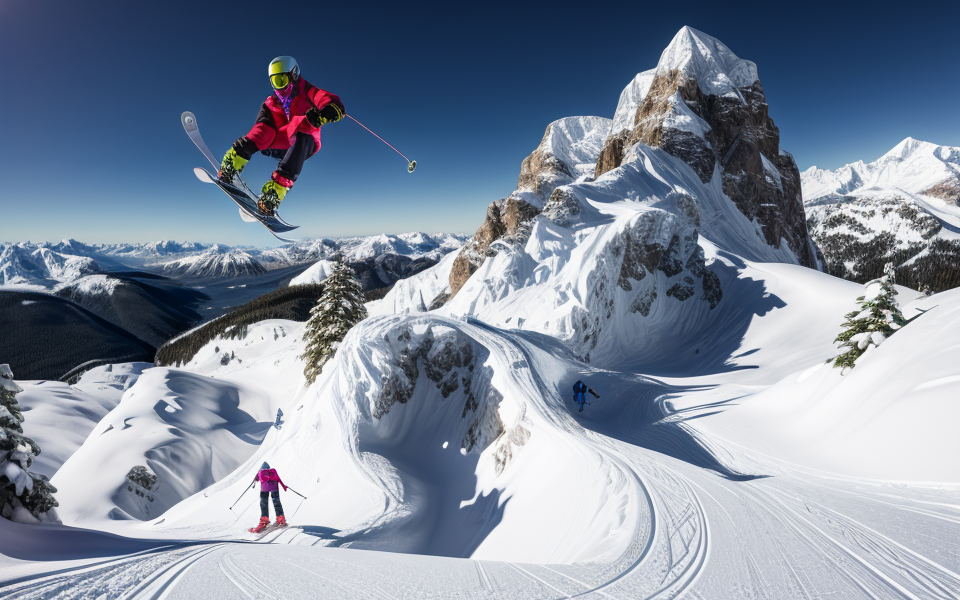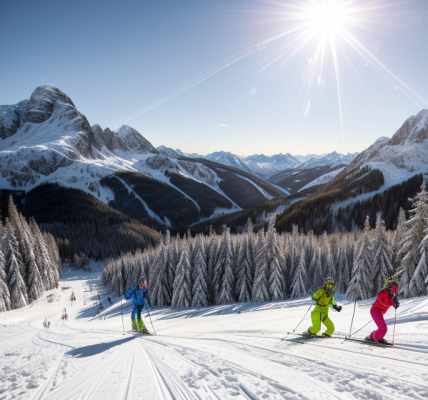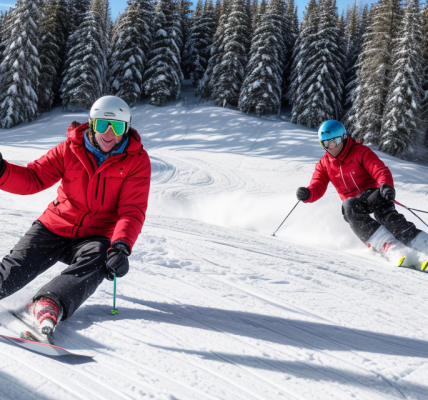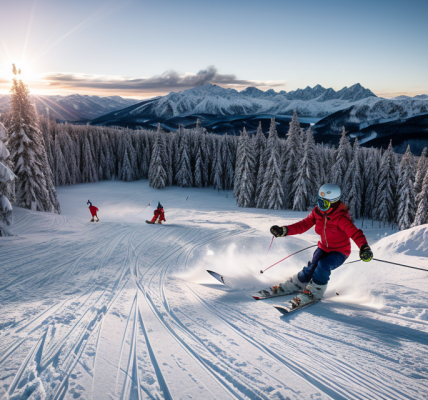Skiing is often perceived as a purely physical activity, requiring strength, agility, and finesse. However, a closer look reveals that mathematics plays a crucial role in this seemingly simple sport. From calculating angles and speeds to perfecting technique, math is woven into the fabric of skiing. In this exploration of numbers in skiing, we will delve into the mathematical concepts that underpin the sport, uncovering the hidden mathematical patterns that govern the movements of skiers on the slopes. So, strap on your ski boots, and let’s embark on a journey to discover the mathematical intricacies of this thrilling winter sport.
The Numerical Foundation of Skiing Techniques
Algebraic Equations in Skiing
In order to delve deeper into the numerical aspects of skiing, it is essential to examine the algebraic equations that govern various skiing techniques. These equations provide a quantitative basis for understanding the complex interactions between the skier, the slope, and the physical principles that govern their movement.
One of the most fundamental algebraic equations in skiing is the calculation of slope gradients and angles. These measurements are crucial for determining the difficulty of a particular slope and for planning routes that maximize both safety and enjoyment. By utilizing trigonometry and geometry, skiers can calculate the gradient and angle of a slope, allowing them to make informed decisions about their course.
Another key algebraic equation in skiing involves calculating the edge and turn radius. The edge of a ski is the point where the ski makes contact with the snow, and the turn radius is the radius of the curve that the ski follows during a turn. By using algebraic equations to determine the optimal edge and turn radius for a given slope and skiing technique, skiers can achieve greater control and precision in their movements.
Speed and distance projections are also critical algebraic equations in skiing. By calculating the rate of descent and the distance traveled, skiers can gauge their speed and adjust their movements accordingly. These calculations are particularly important for advanced skiers who seek to push the limits of their abilities and achieve greater speeds and distances.
Overall, algebraic equations play a crucial role in skiing by providing a quantitative framework for understanding the complex physical principles that govern movement on the slopes. By mastering these equations, skiers can refine their techniques, improve their performance, and push the boundaries of what is possible on the snow.
Kinematics in Skiing
Kinematics in skiing is the study of motion and the forces that cause it. This branch of physics focuses on the analysis of trajectories, velocities, and accelerations of objects in motion. In the context of skiing, kinematics can help us understand the movements of skiers and the factors that influence their performance.
Projectile Motion and Trajectory Analysis
Projectile motion is a fundamental concept in kinematics, which can be applied to skiing in several ways. For example, when a skier jumps, they can be treated as a projectile, with their initial launch point being the snow surface. The skier’s trajectory can then be analyzed using principles of projectile motion, such as horizontal and vertical displacement, velocity, and acceleration.
Time and Space Coordinates
Time and space coordinates are essential in analyzing skiing performance. By measuring the time it takes for a skier to complete a particular section of the slope and the distance covered during that time, we can calculate the skier’s speed and other relevant metrics. Additionally, the position of the skier in space can be determined using Cartesian coordinates, which can help in understanding the dynamics of skiing movements.
Velocity and Acceleration Dynamics
Velocity and acceleration dynamics are crucial in skiing performance analysis. Velocity can be measured in terms of both speed (magnitude) and direction (angle). Acceleration, on the other hand, can be measured in terms of its magnitude and direction, as well as its rate of change over time. Understanding these factors can help skiers optimize their performance by identifying areas where they can improve their technique.
Mastering the Mathematics of Skiing
Advanced Concepts in Mathematics and Skiing
- Trigonometry in Navigation and Route Planning
Trigonometry, the branch of mathematics that deals with the relationships between the sides and angles of triangles, plays a crucial role in navigating and planning routes on the slopes. By utilizing trigonometric functions such as sine, cosine, and tangent, skiers can accurately calculate distances, angles, and bearings to navigate the mountain terrain effectively. For instance, the cosine rule can be employed to determine the length of a side of a triangle in a three-dimensional space, which is particularly useful when estimating the distance between points on the mountain.
- Calculus in Balancing Forces and Energy Conservation
Calculus, the study of rates of change and slopes, finds application in skiing through the analysis of forces and energy conservation. The forces acting on a skier during movement are a combination of gravity, friction, and air resistance. Calculus can be used to calculate the net force experienced by the skier, which is essential for maintaining balance and optimizing energy expenditure. Moreover, calculus can be employed to determine the gradient of the slope, which is vital for determining the appropriate speed and skiing technique for different terrains.
- Geometry in Formulating Optimal Skiing Trajectories
Geometry, the study of points, lines, and shapes, plays a significant role in formulating optimal skiing trajectories. Skiers must consider various factors such as the shape of the slope, the curvature of the terrain, and the radius of the turns when selecting the most efficient path. By applying geometric principles such as the Pythagorean theorem and central angle relationships, skiers can determine the optimal trajectory that minimizes the time and energy required to complete a run. Additionally, geometric concepts can be used to calculate the optimal banking angle for turns, which is essential for maintaining control and speed.
Applications of Mathematics in Skiing Techniques
The intricate mathematics involved in skiing may come as a surprise to many, but for those who delve deeper, it offers a wealth of insights that can enhance skiing techniques. Here are some of the ways in which mathematics is applied in skiing:
Optimizing Ski Length and Bindings
One of the most fundamental aspects of skiing is the choice of ski length and bindings. Mathematics comes into play in determining the optimal ski length and bindings for a skier’s height, weight, and skiing ability. Ski length is calculated based on the skier’s height and weight, and the ideal ski length can be determined using mathematical formulas. Similarly, bindings are selected based on the skier’s skiing ability and the type of terrain they will be skiing on. Mathematical models can be used to optimize binding settings for different skiing conditions.
Calculating Stance Angles and Body Positioning
Proper body positioning is crucial in skiing, and mathematics can be used to calculate the optimal stance angles for maximum control and balance. Stance angles are the angles formed by the skier’s legs and the ground, and they affect the skier’s balance and control. Mathematical models can be used to calculate the optimal stance angles based on the skier’s height, weight, and skiing ability.
Improving Skiing Techniques with Physics-Based Insights
Mathematics can also be used to gain insights into the physics of skiing, which can help skiers improve their techniques. For example, understanding the forces that act on a skier’s body during turns can help skiers optimize their body positioning and control. Mathematical models can be used to simulate the forces and movements involved in skiing, providing skiers with valuable insights into how to improve their techniques.
Overall, mathematics plays a crucial role in skiing, from optimizing ski length and bindings to improving skiing techniques with physics-based insights. By harnessing the power of mathematics, skiers can gain a competitive edge and enhance their skiing experience.
Skiing as a Tool for Mathematical Learning
Mathematical Concepts Demystified through Skiing
Skiing, a popular winter sport, offers a unique opportunity to explore mathematical concepts in a practical and engaging way. By integrating mathematics into the sport, skiers can develop a deeper understanding of mathematical principles and demystify concepts that may seem abstract in a classroom setting. In this section, we will delve into how skiing can help demystify mathematical concepts such as fractions and decimals, ratios and proportions, and algebraic expressions.
Fractions and Decimals in Edge Control
Skiing requires precise control over one’s edges, or the ability to balance and maneuver the skis effectively. This control is closely related to the concept of fractions and decimals. For example, when adjusting one’s edge angle, a skier must consider the ratio of the ski’s length to its width, which is a fraction. Similarly, the distance between a skier’s two feet on the snow is a fraction of the ski’s length. By applying mathematical concepts in edge control, skiers can make more precise and accurate movements on the slopes.
Ratios and Proportions in Terrain Analysis
Skiers often analyze different terrains to determine the best routes and avoid obstacles. This process involves understanding ratios and proportions, which are essential mathematical concepts. For instance, a skier may need to determine the ratio of the slope’s steepness to its length or the proportion of the terrain’s openness to its obstacles. By using these ratios and proportions, skiers can make informed decisions about their route and adjust their skiing style accordingly.
Algebraic Expressions in Slope Navigation
Skiers also use algebraic expressions to navigate the slopes effectively. For example, when calculating the time it takes to descend a slope, a skier must consider factors such as speed, distance, and altitude change. These factors can be represented algebraically, allowing skiers to make predictions and adjustments based on mathematical principles. Similarly, when determining the optimal line to take on a slope, skiers may need to solve algebraic equations to account for factors such as slope angle, wind, and snow conditions.
In conclusion, skiing offers a unique opportunity to demystify mathematical concepts and make them more accessible and engaging. By integrating mathematics into the sport, skiers can develop a deeper understanding of mathematical principles and apply them in practical situations on the slopes.
Skiing as a Catalyst for Developing Problem-Solving Skills
Skiing can be an excellent tool for developing problem-solving skills, as it involves analyzing various data points and applying mathematical models to improve performance. The following are some ways in which skiing can be used to enhance problem-solving abilities:
- Analyzing Slope Data and Weather Patterns: Skiers must constantly analyze slope data and weather patterns to make informed decisions about their skiing routes. This involves understanding concepts such as angle of inclination, gradient, and wind speed, and using this information to plan their descents. By doing so, skiers can develop their problem-solving skills by considering multiple variables and making strategic decisions based on their analysis.
- Applying Mathematical Models to Skiing Techniques: Skiing involves a range of mathematical models, such as kinematics and dynamics, which describe the motion of objects. Skiers can use these models to optimize their skiing techniques, such as determining the optimal angle of attack for a given slope or calculating the optimal radius of turn for maximum speed and control. By applying mathematical models to their skiing techniques, skiers can develop a deeper understanding of the physics behind their movements and improve their overall performance.
- Identifying Patterns and Trends in Skiing Performance: Skiers can also use data analysis to identify patterns and trends in their skiing performance. This might involve tracking their speed, distance, and altitude over time, and using this data to identify areas for improvement. By analyzing their performance data, skiers can develop their problem-solving skills by identifying patterns and trends, and using this information to make informed decisions about their skiing techniques.
The Future of Math and Skiing
Advancements in Technology and Mathematics in Skiing
The integration of technology and mathematics in skiing has revolutionized the sport, providing skiers with new tools and techniques to enhance their performance. The following are some of the advancements in technology and mathematics in skiing:
Integration of Machine Learning and AI in Skiing Techniques
Machine learning and artificial intelligence (AI) are being used to analyze skiing data and provide insights into the sport. Skiers can now use machine learning algorithms to analyze their skiing technique and identify areas for improvement. This technology can also be used to develop personalized training programs that are tailored to the individual skier’s needs.
Furthermore, AI-powered systems can analyze skiing data in real-time, providing instant feedback to skiers on their technique and performance. This can help skiers make adjustments to their technique on the fly, allowing them to improve their performance during a competition or training session.
Virtual Reality and Simulation in Skiing Instruction
Virtual reality (VR) and simulation technology are being used to provide skiers with a more immersive and interactive learning experience. Skiers can now use VR to simulate different skiing conditions and scenarios, allowing them to practice and improve their technique in a safe and controlled environment.
VR technology can also be used to create personalized training programs that are tailored to the individual skier’s needs. By analyzing data on the skier’s technique and performance, VR systems can create a virtual environment that simulates the specific conditions and challenges that the skier will face on the slopes.
Big Data Analytics for Skiing Performance Optimization
Big data analytics is being used to analyze skiing data and provide insights into the sport. Skiers can now use big data analytics to track their performance over time, identifying trends and patterns in their technique and performance.
Furthermore, big data analytics can be used to identify areas for improvement in skiing technique and performance. By analyzing data on factors such as speed, distance, and trajectory, skiers can identify areas where they can make adjustments to their technique to improve their performance.
Overall, the integration of technology and mathematics in skiing is providing skiers with new tools and techniques to enhance their performance and take their skiing to the next level.
The Intersection of Skiing and Mathematics in Education
Developing Math-Skiing Integrated Curriculum
In order to create a more well-rounded educational experience, some schools are beginning to incorporate skiing and mathematics in their curriculum. This approach seeks to bridge the gap between theoretical math concepts and practical real-world applications. By developing a math-skiing integrated curriculum, students can learn math in a more engaging and interactive way. For instance, they can analyze slope angles, calculate trajectories, and measure speeds to better understand the physics behind skiing. Furthermore, they can also explore how mathematical principles are used in the design and manufacturing of skis and other ski equipment.
Fostering Mathematical and Skiing Talent in the Next Generation
By incorporating skiing and mathematics in education, students can be encouraged to develop their skills in both areas. This can help identify and nurture talent in students who may have a passion for both skiing and math. With this integrated approach, students can benefit from specialized programs that provide opportunities to excel in both disciplines. For example, they can participate in ski racing competitions that require mathematical calculations and strategic planning, such as determining the optimal line and speed to take through a course.
Building a Bridge between Mathematics and Outdoor Sports
Traditionally, mathematics has been seen as a separate and distinct subject from outdoor sports like skiing. However, by integrating the two, students can begin to see the connections between them. This can help foster a deeper appreciation for the role that math plays in many aspects of our lives, including sports and recreation. Furthermore, it can also help to promote a healthy and active lifestyle, as students are encouraged to engage in outdoor activities that require mathematical skills. Overall, this approach can help to build a bridge between mathematics and outdoor sports, creating a more holistic and well-rounded educational experience.
FAQs
1. Is there math in skiing?
Yes, there is math in skiing! From calculating slope angles to measuring the speed and distance of skiers, math plays a significant role in the sport of skiing.
2. How is math used in skiing?
Math is used in skiing in a variety of ways. For example, skiers use trigonometry to calculate the angle of a slope, which is important for determining the appropriate speed and technique for navigating the terrain. Math is also used in the design and manufacturing of ski equipment, such as the shapes and flexibility of skis and the design of bindings.
3. Can math help improve my skiing skills?
Yes, math can help improve your skiing skills! By understanding the principles of physics and math that govern the sport, you can make more informed decisions about your technique and tactics on the slopes. Additionally, many ski coaches use data analysis and statistical techniques to help their athletes improve their performance.
4. What kind of math is used in skiing?
A variety of math concepts are used in skiing, including trigonometry, calculus, and statistics. Skiers use trigonometry to calculate slope angles, while calculus is used to analyze the motion of skiers and the forces acting on their equipment. Statistics is used to analyze data from ski competitions and to track the performance of individual skiers over time.
5. Do professional skiers use math to improve their performance?
Yes, many professional skiers use math and data analysis to improve their performance. For example, skiers may use sensors and other technology to collect data on their speed, position, and other metrics while skiing. This data can then be analyzed using math and statistics to identify areas for improvement and to optimize their technique.



